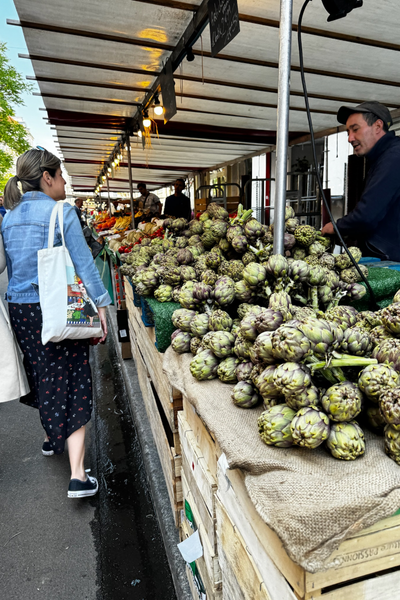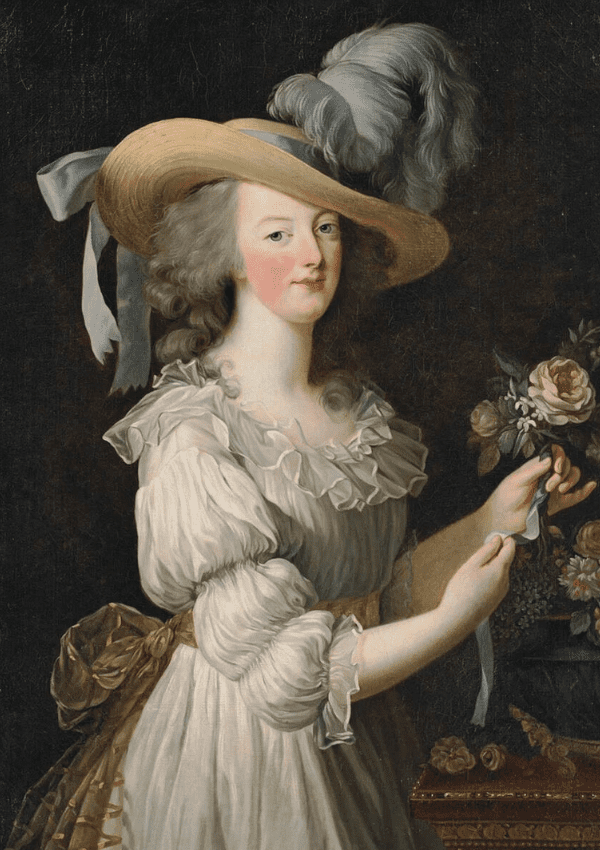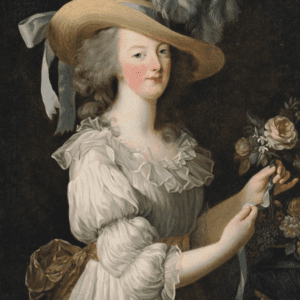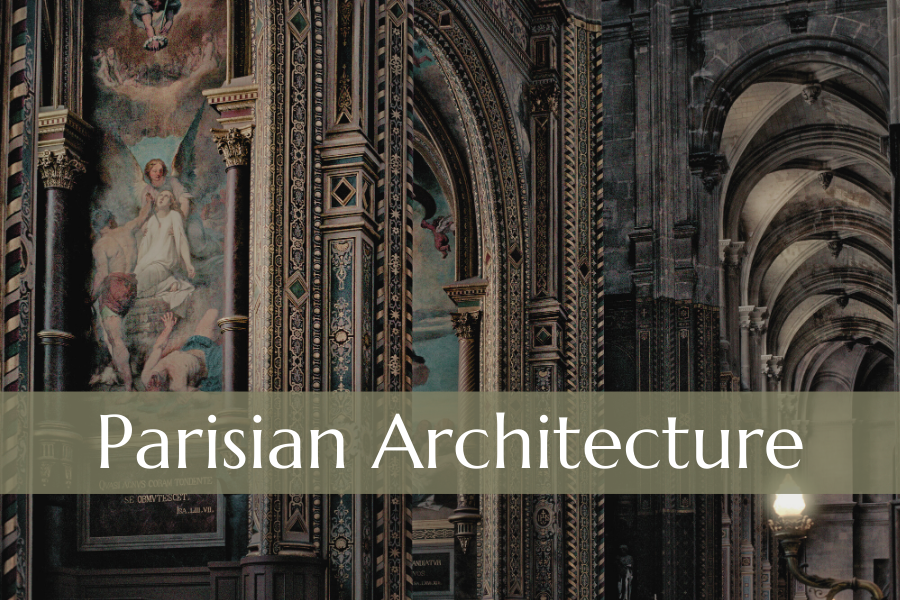
Explore the diversity of Parisian architecture in this guide to the city’s most iconic architectural styles. From the soaring spires of Gothic cathedrals to the harmonious proportions of Renaissance buildings at the Louvre, each style tells a unique historical and cultural evolution story.
Additionally, you will also discover the best places to see and appreciate each architectural style, capturing the essence and evolution of Parisian design.
This post is all about Parisian Architecture.
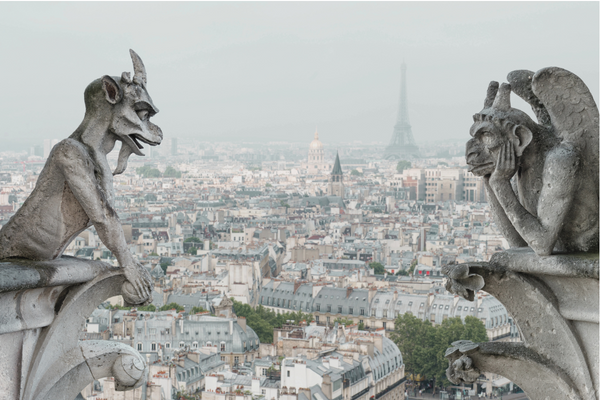
Parisian Architecture: Gothic
Gothic architecture flourished in Europe during the High and Late Middle Ages. This style was all about height and grandeur.
One of the defining features of Gothic architecture is the pointed arch, which contributed to the building’s vertical emphasis and allowed for more stability and weight distribution. The architect’s wish was to construct lighter walls that could support large windows. These windows often feature stained glass designed to fill the interiors with colorful, natural light. At night, these buildings are equally impressive. They assume their more haunted form by candlelight.
Gothic buildings feature intricate sculptures, morbid facades, spooky gargoyles, ribbed vaults, and flying buttresses. This architecture is a testament to the ingenuity and spiritual zeal of the medieval period.
Finally, these giants can be seen as a generational labor of love. Construction could take hundreds of years to complete, and in some cases, when wealthy families ran out of money, local guilds and citizens took over construction. Unfortunately, this style was abandoned when the protestants deemed it impractical and “an affront to God,” or whatever.
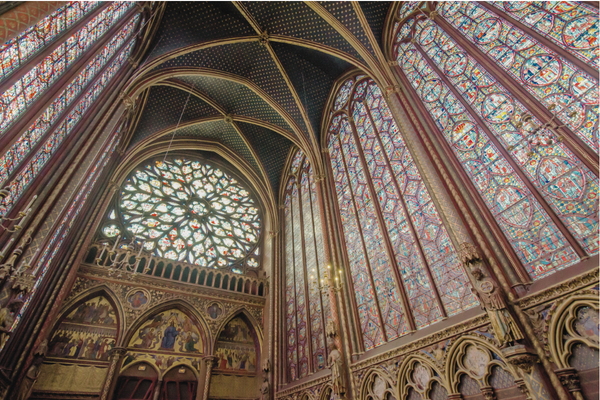
Best Places In Paris to See Gothic Architecture
Notre Dame: Possibly the most famous on this list, Victor Hugo’s novel The Huntchback of Notre Dame made this Cathedral a household name. It glorifies Gothic architecture. I highly recommend seeing its detailed facade by moonlight. (This beauty is on track to re-open to visitors in December 2024.)
Sainte-Chapelle: This royal chapel is located within the medieval Palais de la Cité. It boasts stunning stained glass windows that nearly cover the entire upper chapel. These windows illustrate a pinnacle of Gothic architectural achievement regarding the use of light and space.
Saint-Denis Basilica: This basilica is located in a suburb of Saint-Denis. It is the first major structure primarily built in the Gothic style and is notable for its pioneering use of structural elements like pointed arches, ribbed vaults, and flying buttresses. One of the OGs.
Saint-Severin Church: Saint-Severin stands out In the Latin Quarter because of its flamboyant (Yes, that’s a technical term) Gothic features. Its most popular features are the twisted columns in the ambulatory and the magnificent stained glass.
Saint-Eustache Church: Near Les Halles, Saint-Eustache offers a blend of Gothic and Renaissance styles. Gothic elements are particularly notable in the structure’s grand scale and the elaborate flying buttresses. Check out this show that brings this Church and its architecture to life!
Saint-Jacques Tower: If you visit Paris to see a tower, make it this one. She will not sparkle at midnight, but she has spooky little gargoyle boys. Unfortunately, the tower is all that remains of the former 16th-century Church of Saint-Jacques-de-la-Boucherie. The tower is a beautiful example of Flamboyant Gothic architecture and was an important landmark for pilgrims starting their journey to Santiago de Compostela.
(Here at Outlaw Academia we lean Gothic in our architecture. COMING SOON: Check out our open love letter to Gothic Architecture and learn why it’s for the same reason we love Gen-Z.)
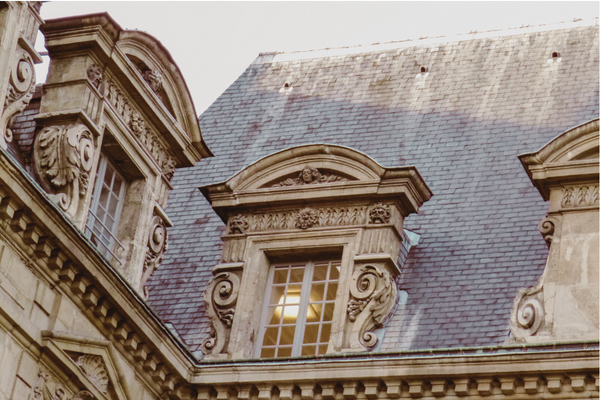
Parisian Architecture: Renaissance
Renaissance architecture emerged during the 15th century and marked a revival of Classical Roman principles, emphasizing symmetry, proportion, and geometry. This style spread throughout Europe, transforming the skylines’ distinctive aesthetics until the 17th century.
Renaissance architecture also features domes and columns that mirror the grandeur of ancient Rome. These elements were used to inspire a sense of enduring stability and grace. Renaissance buildings typically feature structured façades, often arranged in defined ratios and adorned with pilasters and pediments.
Classical detailing usually frames the windows and doors, and grand staircases and spacious chambers mark the interiors. Combined, these elements reflect the era’s ideals of beauty and rationality. (Like in the photo of Hôtel de Sully above.)

Best Places to See Paris’s Renaissance Architecture
The Louvre Palace: Initially, the Louvre was a medieval fortress. Later, Francis I transformed it into a royal palace with extensive Renaissance renovations. People particularly celebrate the Lescot Wing for its pure French Renaissance style.
Hôtel de Ville: Paris’s city hall, while largely rebuilt in the 19th century in a style that mimics the Renaissance, originally had elements from the Renaissance, particularly in its elaborate façades and decorations.
Hôtel de Sully: This mansion is located in the Marais district. It was built at the end of the 16th century. It features a delicate courtyard and a garden typical of the Renaissance period, with architecture that includes classical columns and pilasters.
Hôtel Carnavalet: Also in the Marais, this mansion houses the Museum of Paris History and includes architectural elements typical of the French Renaissance, such as sculptures and dormer windows integrated into a classic Renaissance structure.
Fontainebleau: While technically not in Paris, the Château de Fontainebleau is a must-see for Renaissance architecture enthusiasts. French monarchs favored it as a residence and extensively renovated it during the Renaissance.
Hôtel de Cluny: Currently housing the Museum of the Middle Ages, this building combines Gothic and Renaissance elements. The Renaissance aspect is most visible in its decorations and the later additions to the medieval structure.
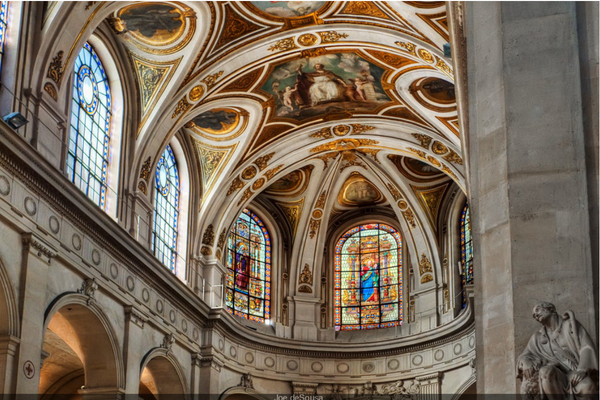
Parisian Architecture: Baroque
Baroque architecture is an exuberant style that emerged in the late 16th century. Its complexity and dramatic intensity distinguish it. Baroque buildings often feature bold, curving forms, large-scale decoration, and an overall sense of movement within the architecture. This style aims to evoke emotion and convey the power and glory of the Catholic Church during the Counter-Reformation.
Key elements of Baroque architecture include grandiose scale and high levels of detail. Facades are typically more theatrical and ornate, often extending into expansive colonnades. The interiors are just as elaborate, with vibrant frescoes, intricate stucco work, and lavish use of gold.
Additionally, the use of light and shadow (chiaroscuro) and trompe l’oeil (optical illusion) paintings enhance the sensory experience. These techniques make the structures appear more dynamic and animated.

Best Places to See Paris’s Baroque Architecture
Les Invalides: This complex was originally built as a hospital and retirement home for war veterans. Today, it is officially known as L’Hôtel National des Invalides. It features a majestic dome designed by Jules Hardouin-Mansart, one of the finest examples of French Baroque architecture.
The Church of the Val-de-Grâce: Built as part of a royal abbey, Queen Anne of Austria ordered the Church of the Val-de-Grâce. Its intricate design and the lavish decoration of its dome interior are key examples of Baroque sensibilities in religious architecture.
Luxembourg Palace: This palace was built as a royal residence for Marie de Medici. It combines traditional French architecture with Baroque influences, particularly in its garden façade and the elaborate Medici Fountain.
The Sorbonne Chapel: Completed in the 17th century, the Sorbonne Chapel is part of the historic University of Paris. Its design features a richly decorated interior and a striking dome, reflecting the Baroque emphasis on emotional engagement and detailed craftsmanship.
The Church of Saint-Roch: Located on the Rue Saint-Honoré, this church is an excellent example of Baroque architecture. Its dramatic interior includes ornate chapels and a lavish high altar. The church’s design reflects the theatricality and elaborate detail typical of the Baroque style.
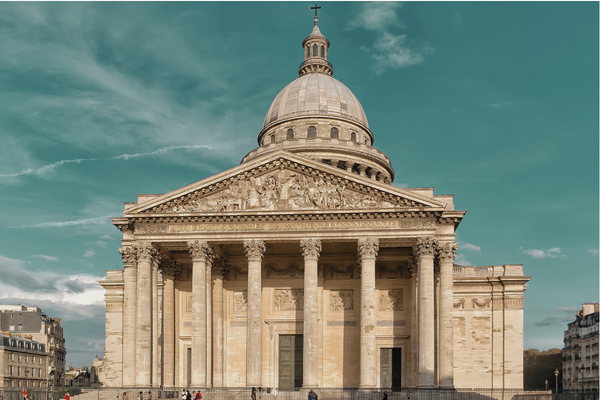
Paris’s Neoclassicism Architecture
Neoclassicism is an architectural style that emerged in the mid-18th century. Drawing inspiration from the simplicity and symmetry of ancient Greek and Roman buildings, this movement sought to revive the ideals of classical antiquity, particularly the principles of “clarity, harmony, and restrained elegance” (aka “being kinda boring.”)
Neoclassical architecture features a grand scale and formal design characterized by geometric forms, including columns, domes, and triangular pediments. Facades are typically flat and symmetrical, and pilasters. (Laurel wreaths and shields everywhere.) Similarly, refined and symmetrical interiors focus on proportion and favor a muted color palette to enhance the overall sense of “dignity and grace” (aka “a little bit sterile.”)
This architectural style symbolizes democracy and morality, influenced by the Enlightenment’s ideals of reason and order.
Best Places to See Paris’s Neoclassicism Architecture
Panthéon: Originally designed as a church dedicated to St. Genevieve, the French Revolution transformed the Panthéon into a mausoleum. Its façade, modeled after the Pantheon in Rome and featuring Corinthian columns and a triangular pediment, epitomizes Neoclassical aesthetics.
La Madeleine Church: La Madeleine is one of Paris’s most striking examples of Neoclassical architecture. Designed as a temple to the glory of Napoleon’s army, its structure models an ancient Roman temple surrounded by Corinthian columns.
Palais Bourbon: Home to the French National Assembly, this building features a classical façade with a prominent colonnade, reflecting the Neoclassical style. Originally built for the daughter of Louis XIV, it underwent several modifications to mirror the changing architectural tastes.

Paris’s Haussmannian Architecture
Finally, close your eyes and think of Paris. Yep, that’s Haussmannian architecture. That cutie pie wrought-iron balcony in your hotel room you paid extra for? Again, Haussmannian architecture. That little cafe that makes you feel like a writer from the lost generation? You guessed it, Haussmannian architecture.
Haussmannian architecture refers to the distinctive style that emerged during Baron Haussmann’s extensive renovation of Paris in the mid-19th century. This architectural form is synonymous with Paris’s grand boulevards and uniform cityscape, designed to embody elegance, order, and the modern vision of urban planning.
Renowned for their stone facades, often cut from light-colored limestone, Haussmann buildings lend the city its characteristic glow. These buildings typically feature a consistent, regulated height—often five to six stories—with the second floor usually adorned with elaborate balconies. The ground floors often host shops or cafes, enhancing residential and commercial use.
The rooftops are steeply pitched and adorned with mansard roofs, often with dormer windows, allowing for attic living spaces. This style emphasizes symmetry and alignment across facades, contributing to the harmonious appearance that defines Parisian boulevards.
Best Places to See Paris’s Haussmannian Architecture
Boulevards and Avenues: The grand boulevards are the most prominent feature of Haussmann’s renovations. Examples include Boulevard Saint-Germain, Boulevard Haussmann, and Avenue de l’Opéra. These wide avenues facilitated better traffic flow, improved air quality, and transformed Paris into a “City of Light.”
Apartment Buildings: Haussmannian buildings can be seen throughout central Paris. They are usually five to six stories tall, with a stone façade, wrought-iron balconies, and a mansard roof. The ground floor often houses shops with residential apartments above, featuring high ceilings and large windows.
Place de l’Étoile and the Arc de Triomphe: The layout of the Place de l’Étoile, now known as Place Charles de Gaulle, with twelve avenues radiating from the Arc de Triomphe, is a classic example of Haussmann’s impact on urban planning. This star-shaped arrangement enhances the monument’s visual impact.
Parc Monceau: While not an architectural structure, the layout of Parc Monceau and other public parks like Parc des Buttes-Chaumont was part of Haussmann’s vision for Paris. Designers created these parks to provide recreational spaces for the city’s inhabitants and to beautify the city.
Rue de Rivoli: Haussmann extensively redeveloped this major street. It showcases uniform building façades, a hallmark of Haussmannian architecture, intended to present a cohesive aesthetic emphasizing harmony and order.
This post was all about Parisian Architecture.
Related Reading
Why You Should Drink ‘Til It’s Blurry At Monet’s Garden
Marie Antoinette: Tradwife Life Got Her Murdered By the Populace
11 Paris Travel Essentials and How to Pack Like a Parisian
Get Lost In Lost Generation Territory of Paris
3 Reasons to Fall in Love With Parisian Cafe Culture
12 Powerful Books to Make You Fall in Love with Paris

